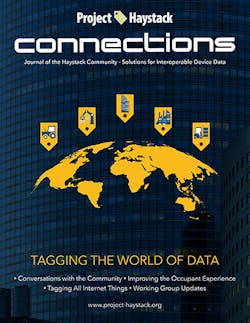Latest from IoT
Sponsored
What are Stackable Semantics? And why do they make for an awesome user experience - UX – while allowing us to achieve Virtual Visibility? Why do we seek – no – demand that they be part of the myriad of IoT device data that is creeping and leaping into our buildings?
Continuing my never-ending story that links a lot of pieces of our future together, I will start with a breakdown of my title and the history of Project Haystack.
By stackable we mean an orderly pile, especially one arranged in layers. Semantics is the branch of linguistics that deals with the study of symbols, how they denote meaning, and how those meanings change.
When something is very difficult to find it is like looking for a needle in a haystack. Essentially because the area you have to search is too large and the size of what you are looking for is very small.
Daily we add IoT devices and data to our buildings creating a haystack of information from which, without a naming system — a Stackable Semantic — we have no hope of retrieving the specific, significant data we are seeking.
This review from 2016, How to Build a Haystack gives a run-down on the history of Haystack as documented on AutomatedBuildings.com. Even I was amazed at the length and depth of our journey to date. The journey began with:
April 2011
Finding the Needle -- The emerging field of analytics is the key to turning the data from smart systems into actionable intelligence. - John Petze, C.E.M. Partner, SkyFoundry
May 2011
Project-Haystack -- We are now awash in large volumes of data, but we can’t easily derive value from it. Project Haystack's mission is to define this common vocabulary so that we can derive value from all the data our building automation systems are collecting. - Brian Frank, Founder, SkyFoundry
I feel very much a part of the amazing Project-Haystack.org open source community. Our contributing Editor, Therese Sullivan, of BuildingContext Ltd (who is also Managing Editor, Haystack Connections Magazine) wrote this article, Semantic Tagging Passes an Inflection Point, which provides more history of the movement. From the article:
There was no pushback from any company regarding the need to support standardized tagging. They are either already doing it, or it is top on their roadmap. They all understand this is where the industry is headed.
The Spring 2018 edition of Project Haystack Connections documents how fast the evolution toward smarter buildings can happen once building operational data has been tag-enabled. Both IT and OT contingents are recognizing that metadata tagging is key to clearing hurdles related to ease-of-use, unified data flow edge-to-cloud, data security and even adhering to new GDPR data privacy rules. Not to be missed is the fact that the storytellers in this issue — especially those that I interview in the Q&A section — are not solution vendors, but are from the ranks of design engineers, commissioning experts, smart building consultants, and large-portfolio property managers.
The Spring 2018 issue, which is our fourth issue, of the Project Haystack Connections Magazine is published! It is growing in readership as the industry comes to understand the mission of the Project Haystack Organization and the importance of making it easy to work with the data produced by smart, connected devices and equipment systems.
Project Haystack Connections Magazine for Spring 2018 had the theme, 'Tagging the World of Data.' The issue contains interviews with a good sampling of Haystack Tagging end-users from the ranks of design engineers, commissioning experts, smart building consultants, and large-portfolio property managers. Around the DDC world, people are recognizing that metadata tagging is key to clearing hurdles related to ease-of-use, unified data flow, edge-to-cloud, data security and even adhering to the new GDPR data privacy rules. Let me pull a few highlights from this valuable issue:
Page 11
Q: What do you think of ASHRAE’s announcement about collaboration on Data Semantic Modeling under Standard 223P?
A: A common data semantics system is going to reduce friction among all the data-driven solutions aimed at commercial and industrial building owners and operators. The Smart Buildings industry has been offering lots of technology to reduce energy costs, to improve facility management efficiency and real estate operations, to increase the performance of physical security and safety in buildings. However, what we have seen so far is “internet of a thing.’ That is, a lot of focus on one thing, be it lighting, video, physical access, etc. The work of standardizing tagging methods and schema could be the catalyst which rises us above the silos, cross-pollinates ideas, and eventually knocks down the barriers.
Page 14
“Altura is pioneering a new class of service—full-lifecycle asset management in a tag-based environment....”
Page 21
“By doing this once thoroughly and explicitly, we hoped to save our project and facility teams any time and effort they would otherwise put into naming, and increase the chances of long-term success with analytic tools.“
Page 23
“We want to capture more than just point-naming. The objective is to make it easy to track key performance data for single buildings, campus systems, or nationally connected systems.”
Page 26
Here is how Haystack’s interoperability and semantic modeling capabilities helped VRT Systems developers quickly build a solution that provides building occupants with a window into their data in real time and in an easy manner.
Page 34
Project Sandstar
Our group is working to improve Haystack ops such that Sedona components can be created, changed, deleted and linked. It is paving the way for artificial intelligence to be utilized to generate and improve upon human-generated DDC code. You can learn a lot more about Project Sandstar by watching my demo as presented on ControlTalkNow.
Page 37
Audio Stream of “Making Internet of Things Device Data Just Work!” a Memoori webinar featuring John Petze and Marc Petock on Project Haystack
Making Internet of Things Device Data Just Work! Memoori Talked to John Petze and Marc Petock from Project Haystack about the importance of data interoperability and how Project Haystack provides a universal markup language to capture IoT device data semantics.
In this Q&A session with John and Marc, we dig into the details of the open source Project Haystack and discuss its importance to IoT data;
* Data interoperability and how Project Haystack provides a universal markup language to capture IoT device data semantics.
* The challenge – Making device data self-describing for easier use across applications. How the open-source Haystack standard addresses the need.
* The Haystack Community – An update on the adoption of Haystack, advances in the technology, and the activities of the community worldwide.
Ready to Seek Stackable Semantics? Here is a link to the specifications to add to your next project,
Guide Specification for Data Modeling of Building Systems and Equipment Based on Project Haystack Open Source Data Modeling Standard v2013-10-1
1.0 Purpose: The purpose of a data modeling standard is to provide a consistent, standardized methodology for naming and describing data points associated with facility automation systems, equipment systems, energy metering systems, other smart devices including mobile assets, and associated descriptive information known as metadata.
You can download all the recent issues of Haystack Connections Magazine at:
https://www.project-haystack.org/download
I hope that I have caught your attention on the importance of seeking stackable semantics to find the needle in the haystack and make all you do virtually visible.
Ken Sinclair | Editor/Owner/Founder
Ken Sinclair has been called an oracle of the digital age. He sees himself more as a storyteller and hopes the stories he tells will be a catalyst for the IoT future we are all (eventually) going to live. The more than 50 chapters in that ongoing story of digital transformation below are peppered with HTML links to articles containing an amazing and diverse amount of information.
Ken believes that systems will be smarter, self-learning, edgy, innovative, and sophisticated, and to create, manage and re-invent those systems the industry needs to grow our most important resource, our younger people, by reaching out to them with messages about how vibrant, vital and rewarding working in this industry can be.



